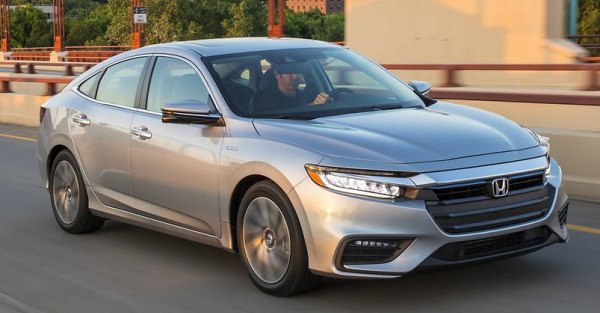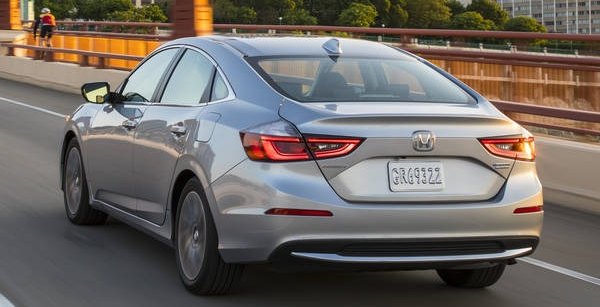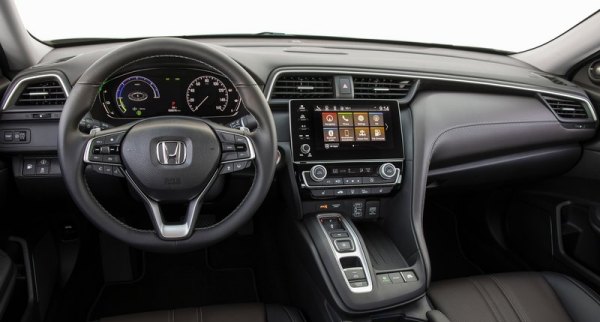Published
on 22
Jun 2018
|
All rights reserved.
|
|
|

|
|
It
doesn’t take an insight to learn that the new Insight is actually a
Civic Hybrid...
|
|
Since its birth in 1999,
Honda Insight has been swinging from one extreme to another extreme.
The original Insight was a tiny,
coupe-like 2-seater. It was somewhat
an experiment to achieve record-breaking fuel economy (61mpg city or
70mpg highway, according to EPA), thanks to the company’s first IMA
hybrid powertrain and a teardrop shape. With 17,000 units sold, it was
considered successful for such a niche car. However, in the second
generation, Honda lifted its ambition and targeted it at the mass
market. The Insight was converted into a 5-door family hatchback.
Initially it sold well, especially back in Japan where 100,000 sales
were recorded in the first year. Then it started sliding. Facing the
double-attack from Toyota Prius Mk3 and Aqua (Prius C), its IMA hybrid
technology became obviously inferior. Eventually it left the world
silently in 2014.
Not just Insight, the entire IMA hybrid strategy of Honda has been
proved less than successful. Two and a half years ago, we were
surprised that the 10th generation Civic came without Hybrid version,
unlike the last 3 generations preceding it. Now we know why: it became
the new
Insight. Combining two unsuccessful products into one might not bring a
different result, but at least it will save money.
It doesn’t take an insight to learn that the new Insight is actually a
Civic Hybrid. You can see from its familiar look as well as all the key
dimension measurements, such as the 2700mm wheelbase. Honda wants you
to believe it is half a class higher than Civic and half a class lower
than Accord, so it tweaks the styling a bit, giving it an Accord-style
nose (which still looks strange to me) and a more upmarket tail. That
said, you can clearly see its Civic underpinnings from the same
proportion and even the same windows. Moreover, you get no more extra
space from the cabin, so it is hard to see it as something
slotting between Civic and Accord, at least before you look at its
price list. For these reasons, I opted to put this article in the
section of Civic instead of opening a new page.
 |
|
The
engine spins like crazy during acceleration, and refinement suffers...
|
|
The outgoing IMA
(Integrated Motor Assist) formula was renowned for
compactness, lightweight and lower costs, but the flipside was limited
performance and efficiency. Unlike the hybrid systems of Toyota and
most other manufacturers, it employed a single motor for both
propulsion and regeneration, thus neither duties were optimized.
Moreover, to save a complex transmission, it had the motor connected to
the engine permanently, so it wasted power to turn the engine even when
the latter is not in use. Honda abandoned the IMA concept and turned to
a conventional 2-motor system since the last generation Accord Plug-in Hybrid.
It was developed further in the current Accord Hybrid and now the
Insight is the third attempt, albeit in a smaller, less powerful
package. It uses a larger motor for propulsion, offering up to 197 lbft
of torque and 129 horsepower. The gasoline engine is a 1.5-liter DOHC
i-VTEC (variable cam phasing the 2-stage cam profile switching serve
only the intake side), running in Atkinson cycle to enhance thermal
efficiency to a remarkable 40.5 percent, slightly better than that of
Toyota Prius. It produces another 107 horses and a modest 99 pound-foot
of torque. Combining them results in 151hp and, strangely, again 197
lbft.
While other 2-motor hybrid systems employ a planetary transmission to
merge both power sources together and achieve the effect of CVT, Honda
skips planetary transmission and opts for a fixed gear direct drive to
save weight and cost. Its propulsion motor is geared to the front axle
directly, so for most of the time the car is driven by the motor. The
gasoline engine mainly works as a generator, pulling the generator
motor to supply electricity to the propulsion motor and/or to recharge
the battery. This means it is a “series hybrid” for most of the time
(engine -> generator motor -> propulsion motor -> wheels).
However, when
the car is cruising at high speed, a clutch can lock up the engine to
the front axle, thus the car is driven by the engine directly, which is
more efficient than going through the hybrid system (because the
efficiency of electric motor decays at high rev). Only when you floor
down the throttle both engine and motor will work at the same time to
provide full thrust. In this case, you may call it “parallel hybrid”.

|
|
It
feels more upmarket than Civic, but you won’t confuse it with a
Mercedes A-class.
|
|
Despite the lack of a planetary CVT, the Insight works like other
hybrids in reality. Its 1.1 kWh lithium-ion battery provides negligible
zero-emission range – it’s not a plug-in hybrid, after all – and its
engine spins like crazy during acceleration, much like a car equipped
with a conventional CVT. This means refinement suffers (by the way,
tire noise is also too intrusive). Accord Hybrid has the latter
problem, too, but the Civic’s…er, Insight’s smaller engine amplifies
the problem. On the plus side, its performance obviously outclasses
Toyota Prius, taking just over 8 seconds to do 0-60mph, thanks to its
stronger electric motor. On energy saving tires (215/55R16), the
Insight achieves EPA rating of 55mpg city, 49mpg highway and 52mpg
combined, matching the Toyota. This lowers to 51/45/48mpg for higher
spec
models rolling on 215/50R17 rubbers.
Unlike the Prius, there is not much to complain about the handling and
ride of Honda. It drives like a Civic, just a little softer and plusher
thanks to retuned suspension, the use of hydraulic bushings and more
sound deadening measures. Brake modulation is smooth, with none of the
abrupt feeling of some hybrids. Admittedly, Honda opted not to use too
much regenerative braking. The steering has variable ratio but it is
lighter than Civic’s, emphasizing a luxury feel.
Luxury pretension can be found in the cabin as well. The
dashboard is apparently based on Civic’s, but reconfigured slightly,
trimmed with leather (on high-spec models) and more soft-touch
plastics. It feels more upmarket, but you won’t confuse it with a
Mercedes A-class. As in the case of Civic, taller passengers may find
headroom at the back slightly compromised, but legroom is aplenty. Good
news is boot space unaffected by the hybrid conversion, since the
smaller, denser Li-ion battery now fits under the rear seat alongside
the smaller fuel tank. The conventional lead-acid battery
now sits inside the transmission tunnel, as the engine compartment is
fully consumed by motors and power electronics.
At the end, it is still hard to recommend the new Insight unless you
place fuel
economy on top priority (if you do, yes, it is definitely a better
choice than Prius). A Civic is cheaper, more fun to drive and just as
practical to use. Meanwhile, if you want a premium feel, why not buy a
Golf?
|
Verdict:    |
|